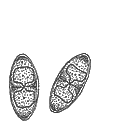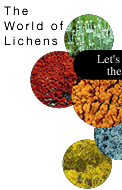

Q.1: Is it true that some lichens are edible?
Ans.
Yes, it is true. Umbilicaria esculenta, which is eaten in Japan, is particularly
famous as an edible lichen. It is introduced in foreign books (fig.12).
Reindeer lichen (Cladonia rangiferina) is known as feed for reindeers.
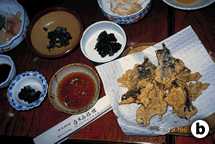 |
|
| fig. 12a: Umbilicaria esculenta in Mt.Azusa, Nagano Pref. | fig. 12b: Tempura of Umbilicaria esculenata |
Q.2: Are there products made from lichens?
Ans.
Litmus papers are made from a chemical substance contained in a lichen
called (Roccellaceae (fig. 13).)
E Fruticose lichen called oak moss (Evernia prunastri) is used to make
perfume.
E Some lichens (Roccella, Parmotrema) are used to dye wool and silk.
E Some lichens (Bryoria, Cladonia, Usnea) are used as dioramic trees and
shrubs for model railroads, etc.
| fig. 13: Roccella sp. from Peru |
Q.3: Are lichens used for medical products?
Ans.
Although usnic acid in some lichens was
used as a disinfectant in the past, it is no longer in use. There are
some lichen substance which is reported as having anticancer effect, but
in order to make use of lichens as medicines, more studies and researches
have to be carried out.
Q.4: How far has the DNA analysis of lichens
progressed?
Ans.
Today, researches using DNA of lichens are widely undertaken as in other
organisms. It is very useful to know phylogenetic relationship between
different genera or species.
Q.5: Are lichens sensitive to air pollution?
Ans.
Lichens are delicately composed upon a symbiotic relation of fungi and
algae. Any environmental change can affect the two symbiotic organisms
at the same time. Therefore, lichens are extremely sensitive to air pollution.
Parmotrema tinctorum would be declined if the concentration of sulfur dioxide
in the air exceeds 0.02 ppm. Because of such sensitivity to air pollution,
lichens are used as the bioindicator.
Q. 6: Do lichens appear in historical documents?
Ans.
The oldest lichens known in history appear in a bible by the name of "Manna."
It is considered to belong to a species of crustose lichens of Lecanoraceae.
Also, if you look at old Japanese folding screens and picture scrolls,
you will notice there are many paintings where lichen-like plants are
depicted on the surfaces of trees. It helps to add ancient look to the
scenery (fig. 14a,b).
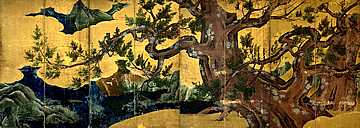
| Fig.PSF | Painting@of old Chamaecyparis
obtusa on a folding screen (169.5 cm x 460.5 cm) by Kano Eitoku. (a national treasure from Tokyo National Museum) Painted in the 16th century (Momoyama Period), it also depicts lichens probably Parmotrema tinctorum or Rimelia clavulifera. |
Curtains in theatres and sliding doors of Japanese rooms called "fusuma" sometimes carry paintings of old pine trees and apricot trees. On their trunks are often seen features resembling Parmotrema tinctorum and Rimelia clavulifera. Painters in Edo period must have known very little about species of lichens but they surely had the knowledge through experience that when trees grow older, many lichens grow on them.
Partial enlarged imagei400~450sNZF62.7kbj
Q. 7: How to collect lichens
Ans.
Methods of collecting lichens differ according to their locations and shapes of thallus. Cladonia rangiferina and Cetraria islandica which adhere loosely to the ground surfaces can easily be collected by hands. In case of crustose lichens or lichens which adhere tightly to substrates, a tanner's knife or a buttonhole knife is used to scrape the lichen off the substrate. Lichens growing on rocks are peeled off together with a thin layer of the rock, using a hammer and a chisel. In that case, the thickness of the rock with lichen should be less than 2 cm in order to preserve it as a specimen.
Ans.
After washing with water, collected items are dried and preserved as dried specimens (fig.15).

|
fig. 15: Making
dried specimens using straps
|
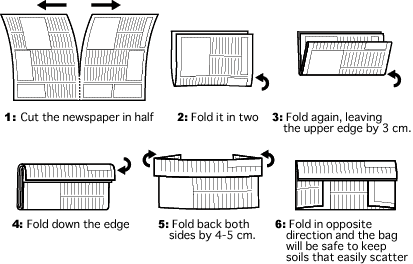
fig. 16: How to make paper bags for drying specimens
In order to dry them, the specimens are put between newspapers with a weight on them. Or, they may be put in a paper bag made of newspapers (fig.16) with some weight on them. If collected lichens are left with moisture in them, mould will grow. So the newspapers should be changed everyday until the specimens are completely dry. As for the weight, books about 2 cm thick will be suitable since too much weight may damage the specimens.
Specimens tightly attached to tree barks or rocks are preserved by pasting them on thick papers together with the substrates. In this way, damage to the specimens will be minimized.
Labels with information such as the name and the location of the collected specimen, its elevation, the date it is collected and the name of the collector written on it (fig. 17c) are pasted on the folded packets (fig. 17). Then the packets are pasted on sheets of standard herbarium papers to be stored.
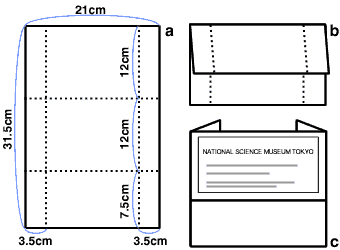
fig. 17: How to make folded packets
| a,b: Fold along the dotted line c: Paste a label |
